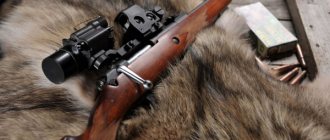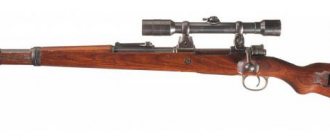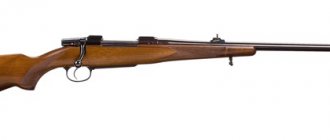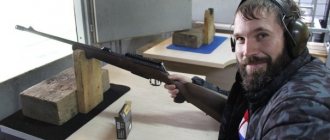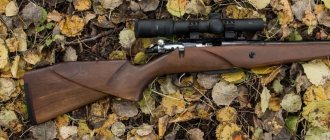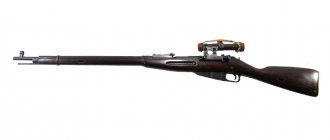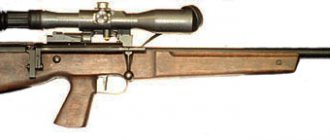This famous “three-line” became the most popular weapon at the beginning of the twentieth century. Although they call it “Mosin rifle” for short, in fact it had several creators and developers. The three-ruler is called the “Three-ruler” because the caliber of its barrel was 3 lines (a line is an old Russian measure of length equal to approximately 2.54 mm, and three lines are equal to 7.62 mm). At the end of the 19th century, the tsarist army was armed with a four-line Berdan rifle, which no longer met the realities of that time and had many shortcomings. In 1882 S.I. Mosin began to improve it.
general information
Sergei Ivanovich Mosin
Guard Captain Sergei Ivanovich Mosin, a hereditary military man originally from the Voronezh province, graduated from the artillery academy.
In 1885, he developed an original rack and pinion magazine, which was subsequently used in the “three-line”, which brought it great popularity.
It reliably ensured the supply of cartridges from the magazine and did not allow two cartridges to enter the chamber at once.
Watch the video:
This is not to say that there were no alternatives to this mechanism, but they were either much more difficult to implement or more expensive.
The Mosin design was a fairly successful compilation of the Bonnet bolts and the Mauser rifle of 1871/84. You can also familiarize yourself with the technical characteristics of the Mauser pistol. It was so convenient that the rifle could be disassembled and reassembled in any conditions, and no special tool was required for this.
Mosin, Mendeleev, Rogovtsev and Nagan who joined them
In the Balkans at the end of the century before last, the Russian army was still fighting with “berdankas” - single-shot rifles developed by the American Colonel Hiram Berdan, when in the West they were already experimenting with repeating repeater rifles. And finally, in 1887, fulfilling the task of the Main Artillery Directorate, the head of the tool workshop of the Tula Arms Plant, Staff Captain Sergei Ivanovich Mosin, created a rifle with a rack magazine in the butt, initially with 8, later with 12 rounds. By that time, the officer already had the Mikhailovsky Artillery Academy under his belt, from which he graduated with a gold medal.
But a truly modern rifle was created only after Dmitry Mendeleev received high-quality smokeless gunpowder, and Colonel N.F. Rogovtsev developed a 7.62 mm cartridge that had a bullet in a nickel silver jacket, which did not wear out the barrel so much.
A sample of a multi-shot rifle by staff captain Sergei Mosin, presented in 1889 to a special commission, competed with the rifle of the Belgian Leon Nagan. During military trials in the fall of 1890, 300 Mosin rifles and 300 Nagant rifles took the combat test. During the shooting, the Mosin rifles had 217 delays when feeding cartridges from the magazine, and the Nagan rifles had three times more delays. Tests have shown that the Russian rifle, although inferior to the Belgian one in finesse and design, has an advantage in reliability and ease of manufacture. However, in the end, Mosin’s sample was accepted only as a basis. It was necessary to make modifications to it both from the Nagan design and those proposed by the specialists who were part of the commission.
© Photo from the archive In 1887, the head of the tool workshop of the Tula Arms Factory, Staff Captain Sergei Ivanovich Mosin, created a rifle with a rack-and-pinion magazine in the butt, initially with 8, later with 12 rounds.
Minister of War Pyotr Vannovsky, presenting the final version for approval to the emperor, wrote: “The new model being manufactured contains parts proposed by Colonel Rogovtsev, the commission of Lieutenant General Chagin, Captain Mosin and gunsmith Nagan, so it is advisable to give the developed model a name: Russian 3-linear rifle model 1891." Alexander III spoke more lapidarily - “a three-line rifle of the 1891 model.” The “three-line” was officially adopted by the Russian army on April 16, 1891.
Reference
The name “three-line” comes from the caliber of the rifle barrel, which is equal to three lines. A line is an obsolete measure of length equal to approximately 2.54 mm. In other words, the term “three-ruler” means the well-known and familiar 7.62 mm caliber.
Interesting historical perspective. Information about the new Russian rifle quickly spread abroad. A Russian military agent in London reported to St. Petersburg that British intelligence managed to obtain a rifle of the 1891 model, and now it is being carefully studied in Britain. The US War Department expressed a desire to adopt the three-line rifle, and the Serbian government asked for permission to order the production of Russian rifles for its army at French factories.
© wikipedia.org
The building of the main building of the Tula Emperor Peter the Great arms factory. Celebrations in 1912 on the occasion of the 200th anniversary of the plant's existence.
Sergei Ivanovich Mosin was not overlooked by ranks and awards, but he was worried that his rifle did not bear his name. By the way, at the proposal of the Minister of War, Mosin was given a bonus of 30 thousand rubles, and Nagan, apparently, as a foreigner - 200 thousand. The name Mosin was finally fixed in the name of the rifle only by the beginning of the 1920s of the last century. Unfortunately, the great Russian gunsmith did not live to see this time; he died in 1902 from pneumonia.
Simplicity in production, high ballistic characteristics and reliability in handling provided the Mosin rifle with enviable durability and made it the most popular domestic small arms of the first half of the 20th century.
The rifle was indeed remarkably simple: unscrew two screws, remove two stock rings, and disassembly is complete. The bolt did not have a separate safety; to protect against accidental shots, you simply had to pull the trigger by the cap and turn it to the left. If it is necessary to urgently open fire, repeat the operation in reverse order. At the same time, the thick chrome-plated barrel withstood almost any impact and could do without frequent cleaning.
The production of rifles in Imperial Russia began in 1892 at the Tula, Izhevsk and Sestroretsk arms factories and, since there was not enough capacity, at the French arms factory in the city of Chatellerault.
Infantry
Infantry
It was the most cumbersome version of the rifle, and without a bayonet it was almost ineffective. Often used over short distances.
During the Russo-Japanese War, the infantry rifle showed high destructive power and, at the same time, a number of shortcomings. The weapon of the first models (before 1894) had an unprotected barrel, and when fired, it became so hot that it burned the soldiers’ hands.
Later, wooden overlays began to be used. In addition, the bayonet mount was fragile and often broke under strong blows.
See also the article about PCP 6.35 rifles without a license. and prices of air rifles for hunting without a license.
Options and packaging
The standard equipment of the carbine includes the following items:
- box;
- ramrod;
- screwdriver;
- breech and muzzle bushing;
- knob;
- wipe and oiler;
- Passport products.
For modification with an optical sight, the following are supplied:
- optical sight – 3.5x, maximum;
- passport for OP.
Mosin rifle - KO91/30
Cossack sample
See photo:
Cossack sample
Made for cavalry and Cossacks. The barrel was 7 centimeters shorter than that of the infantry; a bayonet was not required.
Although the initial speed was slightly lower, overall it was a compact lethal weapon that quickly gained popularity among the soldiers of that time.
Product prices
The KO-30 S rifle is valued by hunters and fully lives up to expectations. Its cost, however, is affordable: the price of a carbine ranges from 26,895 to 32,000 rubles. depending on the condition of the barrel and its authenticity.
The following cartridges are offered for the carbine:
- cartridge Extra 7.62*54 – tombak bullet jacket, brass sleeve. Costs 59 rubles. per piece;
- NPZ cartridge - a bullet with a tombak jacket that prevents barrel wear - 98 rubles. per piece;
- noise refinery cartridge with a bimetallic sleeve - 22 rubles;
- cartridge with increased accuracy - tombak bullet casing, bullet weight 9.9 g - 34 rubles;
- S&B cartridge with improved ballistic characteristics, bullet weight 11.3 g - 161 rubles.
Carbine KO-30S 7.62x54R with TOZ launcher
Dragoon style
Dragoon style
The short barrel and lighter weight made this type more convenient compared to the infantry one. The design of the belt was somewhat inconvenient (you could only carry the rifle on the left), the initial speed of the bullet was slightly lost, but in general the shooting results both with and without a bayonet were good.
In fact, these species differed only in the length of the trunk. The Mosin infantry rifle had the longest barrel and bayonet, the dragoon (or cavalry) had a smaller barrel and a slightly different version of the belt attachment, while the Cossack rifle had no bayonet at all, and the barrel was shortened.
The bayonet model was already a little outdated by that time - it was a tetrahedral bayonet that fits onto the barrel. When the weapon was disassembled, the tip of the bayonet could be used as a screwdriver. See also the material about the domestic rifle IZH 61 here.
Disassembly
The weapon is disassembled and reassembled for cleaning and lubrication after firing. In this case, you cannot apply significant force, otherwise the parts may become deformed.
Partial disassembly - for lubrication, includes the following steps:
- press the trigger, open and pull out the shutter;
- unscrew and remove the cleaning rod. Remove the cover of the magazine box;
- holding the combat cylinder and the handle, retract the trigger until a protrusion comes out of the socket on the screw cut. Then turn the trigger to the left and release;
- holding the bolt, move the bar with the combat cylinder forward and disconnect it from the bolt stem;
- the combat larva is separated from the bar;
- the firing pin is put into the gasket, the handle is pressed and the mainspring is compressed. In this position, unscrew the trigger from the firing pin and remove the firing pin with the spring;
- the mainspring is removed from the firing pin.
If the weapon is to be stored for a long time or the carbine is exposed to moisture, the weapon is completely disassembled. In addition to the above steps, the following are added:
- the stop and tail screws are unscrewed 2 turns and the stock rings are moved forward;
- set the carbine in a vertical position, completely unscrew the screws, disconnect the magazine box, and then the barrel from the stock;
- remove the lid latch from the magazine box;
- disassemble the trigger device - to do this, turn the carbine upside down and support it so that the mechanism does not rest against anything. Unscrew the trigger spring screw and push out the trigger axis;
- disconnect the trigger spring from the hook.
The product is assembled in the reverse order. Cleaning and lubrication is carried out no less than 6 hours after shooting.
Main characteristics of different types of rifles of 1891
| Type | Cartridge | Weight, kg (without bayonet/with bayonet) | Length, mm (without bayonet/with bayonet) | Barrel length, mm | Magazine (number of rounds) | Number of shots per minute | Sighting range, m | Initial bullet speed, m/s |
| Infantry rifle | 7.62×54mm R | 4 / 4,3 | 1310/ 1740 | 800 | 4+1 | 10 | 2200 | 690 |
| Dragoon rifle | 3,9 / 4,2 | 1240/ 1670 | 730 | 4+1 | 10 | 2000 | 660 | |
| Cossack rifle | 3,9 /—– | 1240/— | 730 | 4+1 | 10 | 2000 | 660 |
The first half-million batch of Mosin rifles was manufactured in France (Chatellerault plant); later, in 1893-1894, domestic production was established at the factories of Sestroretsk, Tula, Izhevsk.
In the very first two wars in which the rifle was used (Russian-Japanese and World War I), all its shortcomings became apparent. Some of them were taken into account and adjusted; the dragoon version seemed optimal for use, and only this version began to be produced.
The main complaints were that without a bayonet it was impossible to shoot accurately. If it is not attached to the rifle, then the balance of the weapon is disrupted and the accuracy of the shot is lost, the shooting accuracy deteriorates significantly, and with a bayonet the rifle is very bulky and heavy. Read on to find out what is the best 4.5 caliber air rifle.
Disassembly of the “three-line” was not intended, and certainly with fixed bayonets. Only in 1930 was it possible to eliminate this shortcoming. Then the most significant changes were made to the design of the dragoon “three-line”, and it slightly changed its name (became “model 1891/30”).
Fans of powerful weapons will be interested in material on how to strengthen the Gamo air rifle.
Watch the video of the Ataman air rifle here.
Read about the powerful Barrett rifle at:
The first carbine of the 1907 model
The first serial carbine created on the basis of a three-line rifle was the 1907 model carbine, developed by N. Yurlov. In the army, the carbine was supposed to arm artillerymen, horse patrols, and infantry units. The carbine itself was significantly shorter than the rifle and had a sight for shooting at a distance of up to 2000 steps. Despite the official adoption of the model in May 1907, mass production of the carbine began much later - only in 1909.
Model 1907 carbine. (sitekid.ru)
The Izhevsk plant received the order to produce the carbine. True, the share of carbines in relation to the production of rifles was small, and the planned plan for 1909 for the production of carbines could not be fulfilled. Thus, according to the Most Submissive Report to the War Ministry on the activities and state of all branches of military administration for 1909, it was indicated that the Izhevsk Arms Plant planned to produce 21,157 3-lin. carbines. But before December 1, 1909, only 8,496 units were manufactured.
The situation with the production of carbines continued to remain difficult in subsequent years. So in the report for 1911 Fr. In total, before the start of the First World War, more than 118 thousand carbines were produced - not so much, considering that the production of, for example, infantry rifles before 1914 exceeded 3.3 million units.
This weapon did not become widespread: after the First World War, the carbine quickly disappeared from the army. At the moment, carbines of the 1907 model are museum rarities. Thus, the Central Museum of the Armed Forces in Moscow exhibits a carbine that was presented to Sergei Kamenev, one of the two commanders-in-chief of the armed forces of the Republic during the Civil War.
Mosin sniper rifle
The Mosin rifle is the ancestor of sniper rifles in Russia. The sniper rifle first appeared in 1931; it was designed on the basis of the 19891/30 model.
The sniper rifle had a select barrel with improved accuracy of fire, on the left side of the barrel there was a bracket, a bolt handle bent down, and a smaller and lighter sight. Watch the video:
The main difference, of course, was the presence of an optical sight, which was attached to the barrel on a special bracket. During the war, the Bramit silencer was sometimes used.
The optical sight increased 3.5 times (accuracy increased at a distance of up to 1300 meters), its weight was 270 g, its length was 169 millimeters, the field of view was 4° 30′. However, due to the installation of an optical sight, it was necessary to fire single shots.
Performance characteristics of the Mosin sniper rifle:
| cartridge | 7.62×54mm |
| shop | from five cartridges |
| weight | 4.27 kilograms |
| length | 1230 millimeters |
| muzzle velocity | 865 m/s |
| rate of fire | ten shots per minute |
| sighting range | up to 2000 meters |
| reloading | manual |
Sniper shooting was more productive and accurate than regular shooting and caused great damage to the enemy. During the Second World War, the rifle was used very actively.
Text of the book “Combat and service weapons of Russia”
Mosin system rifle mod. 1891
The rifle was developed by Russian Army Captain S.I. Mosin in the late 1880s. Military tests of the rifle were carried out on December 21, 1890; it was adopted by the Russian Army on April 10, 1891 under the designation “Three-line rifle mod. 1891."
Such an impersonal designation violated the traditions of the Russian army, according to which the name of the creator of the weapon was necessarily mentioned in its original designation. It is believed that in this way officials of the Russian Ministry of Defense made a nod to the Belgian L. Nagan, who claimed to be the author of some design solutions implemented in the S.I. Mosin rifle.
It is noteworthy that in the version of the Ministry of Defense the rifle had the designation “Russian three-line rifle mod. 1891,” but Emperor Alexander III crossed out the word “Russian” from the designation.
Initially, the production of Mosin rifles was organized in France (503,539 units were manufactured there until 1895), and specially modernized Russian factories were able to begin producing rifles in the second half of 1893. By 1896, they supplied the Russian army with 1,470,470 rifles , and by 1902 the number of rifles manufactured at Russian factories reached 2,964,484 units. In addition to what was considered the main infantry rifle, dragoon and Cossack rifles of the Mosin system were also produced, differing only in barrel length and some design details.
In 1897, production of three-line carbines began. At the Sestroretsk plant, dragoon and Cossack rifles were converted into carbines, and new carbines were manufactured at the Izhevsk plant.
For many decades, the Mosin rifle was the main individual weapon of Russian and Soviet infantry for defeating the enemy with fire, bayonet and butt. It was the most effective means for hitting single living targets (open, camouflaged, moving and appearing for a short time). The best rifle shooting results were achieved at distances of up to 400 m. Concentrated fire from riflemen was used to hit group targets at distances of up to 1000 m.
The Mosin system rifle became the first repeating rifle of the Russian army. It is equipped with a sliding bolt that rotates when the barrel bore is locked. Locking is carried out by symmetrically located combat lugs of the bolt cylinder. The main design features of the rifle are: a striker-type striker mechanism, a safety device made in the bolt, a trigger mechanism without warning, and powered by cartridges from a vertical magazine box with a single-row arrangement of cartridges.
The infantry rifle has a barrel 800 mm long, in the bore of which there are four right-hand rifling. The back of the bore is smooth, it is the chamber. The chamber is connected to the rifled part of the bore through a bullet entrance.
The shutter is simple, reliable and easy to use. It consists of only seven parts. Disassembling and assembling the shutter is easy and quick, without the use of tools. The fastening of the bolt in the receiver is also original - it is separated after moving it back and simply pressing the trigger, which disables the bolt stop.
The stock is solid, made of wood. The stock has a straight neck of the English type.
The rifle was equipped with a specially developed 7.62 mm cartridge, the bullet of which had an oval head. The mass of the bullet was 13.73 g, the initial speed of the bullet was 620 m/s. The longest sighting range was 1920 m. At a distance of 35 m, the bullet pierced 16–35 one-inch boards.
To improve the ballistic qualities of the rifle, in 1908 a new cartridge with a lightweight pointed bullet was adopted. The mass of the bullet was reduced to 22.45 g, and the mass of the powder charge was increased from 2.2 g for the previous cartridge to 3.25 g. The initial speed of the bullet increased to 860 m/s, while the range of a direct shot and the penetration ability of the bullet increased significantly , and the aimed fire range was 2276 m.
The cartridges were fed from a five-round built-in magazine. The magazine was filled using clips of five or one cartridge each.
Open iron sights include a front sight and a sector sight. On the outside of the sighting bar there are divisions with numbers from 1 to 20, indicating distances in hundreds of meters.
Between the divisions there are small risks for installing the sight with an accuracy of up to 50 m.
The rifle was equipped with a needle bayonet, traditional for the Russian army. In the Red Army, the dragoon rifle was adopted as the main type of individual weapon. In 1930, it was modernized and received the designation “7.62 mm rifle mod. 1891/1930." The modernized rifle was equipped with a new sector sight with a metric scale, the shape of the front sight was changed and new cut spring rings were introduced to more securely fasten the barrel to the stock.
The method of attaching the needle bayonet was also changed.
The total number of manufactured rifles and carbines of the Mosin system reaches 20 million. During the war years, more than 12 million were produced, the absolute majority of which (11 million 145 thousand) were produced by the Izhevsk Machine-Building Plant (plant No. 74).
Carbines of the Mosin system mod. 1907, 1938 and 1944
When developing, adopting and launching the three-line rifle of the Mosin system, the Russian Ministry of Defense completely did not take into account the need to create a carbine on its basis - a significantly shortened and lightweight version of the rifle for use in special forces. This is all the more surprising considering that the Russian Army previously had a carbine based on the Berdan rifle.
The need for such weapons was clearly demonstrated during the Russo-Japanese War of 1904–1905. The example of the German army, which widely used “98” carbines in 1904–1905, was also indicative. while suppressing the uprisings of African tribes against German colonists in South Africa.
In 1907, a commission of the Russian Ministry of War reviewed and approved a carbine based on the Mosin rifle, developed by Major General Yurlov. It was put into service under the designation “Three-line carbine mod. 1907."
Like the rifle, the carbine fired 7.62x54 mm R cartridges, and the rifling in the barrel, bolt, magazine and trigger mechanism were also made in the same way.
The stock was made of birch wood. Stock with a straight neck of the English type.
The forend is attached to the barrel and the receiver lining by two narrow rings, the same as on the Mosin dragoon rifle. The forend contains a ramrod, which is screwed into the ramrod stop.
The barrel guard covers the base of the sight. There are two through holes in the stock for attaching a carrying belt.
The barrel length was 508 mm (20 inches). Four right-hand grooves were made in its channel, as on standard Mosin rifles.
In general, the design of the barrel is not entirely successful: in terms of combat accuracy, the carbine provides dispersion one and a half times greater than that of an infantry rifle.
Like a rifle, the bolt is made with a straight handle, although for a carbine a handle bent towards the fore-end would be more acceptable.
Unlike the rifle, there was no provision for mounting the bayonet on the carbine.
The sights have been newly designed.
The frame sight has reduced dimensions, the block has no steps, the divisions on the frame correspond to installation at a distance from 200 to 2000 steps (142–1420 m).
A significant advantage of the carbine was its very high degree of unification with the standard Mosin rifle. This made it possible already in 1907 to launch its production at the Sestroretsk plant by remaking Mosin’s dragoon rifles, and subsequently to organize the production of new carbines at the Izhevsk plant.
An important role in the adoption of the carbine by the Russian army was played by the fact that Emperor Nicholas II liked it. The latter, for fun, shot at crows from a carbine while walking in the court parks.
Carbines of the 1907 model entered service with soldiers of machine-gun teams, artillery, engineer battalions and convoy teams. Some Cossack regiments were armed with them. The police also received a number of carbines.
During the Civil War and after its end, carbines mod. 1907 were in service with the Red Army, their production continued until 1938, when, based on the modernized Mosin rifle mod. 1891/1930 was created “7.62 mm carbine mod. 1938." This carbine is 5 mm longer than the previous one and is equipped with sights with metric graduations up to 1000 m.
Carbines arr. In 1938, soldiers of special units were armed, but they were also in great demand in the line infantry. It turned out that carbines are more suitable than rifles for combat on rough terrain, in trenches and communication passages, when overcoming various kinds of barriers and obstacles. At the same time, the only drawback of the carbine among the troops was the lack of a bayonet, which is so necessary in close combat.
The Main Artillery Directorate of the Red Army took very energetic measures to eliminate this shortcoming. In May 1943, comparative tests were carried out on eight samples of detachable and permanent bayonets for the carbine. The permanently folding bayonet designed by Semin was recognized as the best. The carbine with this bayonet was adopted by the Red Army by decree of the State Defense Committee of January 17, 1944. By the same decree, the rifle mod. 1891/1930 was discontinued and replaced by a carbine designated “7.62 mm carbine mod. 1944."
The bayonet of the new carbine is needle-shaped, tetrahedral. Its mounting on a carbine allows two positions: the bayonet is folded to the front position and is ready for action in hand-to-hand combat, and traveling - the bayonet is folded back and its blade is adjacent to the fore-end of the stock on the right side.
Shooting from a carbine at ranges up to 300–400 m is as effective as from a rifle mod. 1891/1930, at the same time carbine mod. 1944 is much more convenient and easier.
Automatic rifle of the Simonov system mod. 1936 (ABC-36)
Designer S. G. Simonov developed his first automatic rifle in 1926. The rifle had a number of significant shortcomings, as a result of which the Artillery Committee did not consider it advisable to test it. We must pay tribute to S. G. Simonov: he took into account the committee’s well-founded comments and created several improved versions of the rifle. This made it possible in 1931 to present for testing an automatic rifle that met all the requirements of the Artillery Committee. The rifle successfully passed field tests, and a decision was made to produce a pilot batch of rifles for military testing. At the same time, Izhevsk Plant No. 74 was given an order to prepare for the launch of the Simonov rifle, which had not yet been adopted into service, into full production at the beginning of 1934. The plant's mastery of production of the new product was delayed until 1936, which is explained not only by the plant's unpreparedness for the production of automatic weapons, but also by the need to make numerous changes to the design of the rifle aimed at improving its combat and operational characteristics.
In its final form, the rifle was put into service in 1936 under the designation “7.62 mm automatic rifle of the Simonov system mod. 1936 (ABC-36)."
Gross production of the rifle began in 1938; by 1940, 65,800 ABC-36 rifles were produced.
The ABC-36 design is based on an automation system that operates by using the energy of powder gases discharged through a special hole in a fixed barrel into a gas chamber, located above the barrel for the first time in world practice.
The gas piston, on which the powder gases removed from the barrel are pressed, is connected by means of a rod to a special part called the cocking coupling.
The movement of the cocking clutch is used to impart speed to the bolt and stops when the system is fully unlocked.
The locking unit has an original design.
For the first time in the world, in a weapon of this caliber, the bolt (namely the bolt, not the barrel) is locked by a vertically moving wedge, which is a rectangular prism with a through window for the passage of the bolt and the bolt stem. Lowering the wedge to disengage it from the bolt is done by the cocking clutch, and raising it for engagement is done by the bolt stem during retraction.
It should be noted that this method of locking complicated the design of the rifle and caused characteristic delays associated with feeding the cartridge into the chamber. In addition, it turned out that after complete disassembly, the rifle can be assembled without a locking wedge. Moreover, you can put a cartridge into the chamber and fire a shot. In this case, the shutter will fly back at tremendous speed and cause serious injuries to the shooter.
The striker-type trigger mechanism allows firing both single shots and bursts.
To switch firing modes, a translator is provided, first located in the front of the trigger guard, and subsequently moved to the right side of the receiver.
The rate of fire is 800 rounds/min. The combat rate of fire when firing single shots is 20–25 rounds/min, when firing in short bursts it is 40–50, and when firing automatically continuously it is 70–80 rounds/min. It is noteworthy that continuous shooting was allowed only when repelling an attack, and then no more than four 15-round magazines in a row, otherwise the rifle could fail due to overheating.
The rifle has a barrel length of 615 mm. The barrel bore has four right-hand rifling; the length of the rifled part of the barrel is 557 mm. A massive muzzle brake is attached to the muzzle of the barrel, absorbing up to 35% of the recoil energy.
The barrel is cooled by air; for better air flow, round holes are made in the barrel lining groove.
For bayonet fighting, a bladed bayonet is attached to the barrel. On early modifications of the rifle, it could be mounted both in the firing position and at a right angle to the barrel - for use as a single bipod.
The stock is solid, made of birch wood. The butt has a semi-pistol neck. The stock is equipped with swivels for attaching a carrying belt.
The 7.62×54 mm R cartridge is used as ammunition for the ABC-36. The cartridges are fed from detachable steel box magazines. Initially, magazines with a capacity of 10, 15 and 20 rounds were produced. Since 1936, the 15-round magazine has become the main one. To equip the magazines, standard 5-round clips from a Mosin rifle were used. It was allowed to equip magazines with separate cartridges.
Open iron sights include a front sight and a sight marked at ranges from 100 to 1500 m in 100 m increments.
Some rifles were equipped with an optical sight. Moreover, due to the fact that the extraction of spent cartridges from the receiver was carried out upwards and forwards, the optical sight bracket was attached to the receiver to the left of the weapon axis.
Self-loading rifle of the Tokarev system SVT-38
The Red Army received the ABC-36 automatic rifle before the M1 self-loading rifle of the Garand system entered service with the US Army. The armies of other countries did not have automatic or self-loading rifles before the start of World War II.
As the production of ABC-36 expanded and these rifles entered service with the troops, the number of messages received by the Main Artillery Directorate of the Red Army about the insufficient reliability of the rifle, the ineffectiveness of automatic fire at ranges over 150 m, etc., multiplied. For this reason, on May 22, 1938, that is, just three months after the official launch of the ABC-36 into gross production, the People's Commissariat of Defense announced a competition for the development of a self-loading rifle, which was supposed to replace the ABC-36 in production and among the troops.
According to the tactical and technical requirements developed for the competition, “... the rifle must weigh no more than 4.5 kg... be simple in design, easy to handle and maintain, reliable... have high survivability. Its mechanisms should not fail under any atmospheric conditions, despite dirt and thick grease...”
Tests of the rifles submitted to the competition took place from August 25 to September 3, 1938. Based on the test results, the self-loading rifles of S. G. Simonov and F. V. Tokarev were recognized as the best, although they did not fully satisfy the conditions of the competition. The designers were asked to make appropriate changes to their designs and resubmit them for additional testing. They were carried out on November 20, 1936. The Simonov rifle failed due to insufficient survivability of the firing pin and ejector, which gave rise to the competition committee declaring the Tokarev rifle the best. On February 26, 1939, it was adopted by the Red Army under the designation “7.62 mm self-loading rifle of the Tokarev system mod. 1938 (SVT-38)." However, the adoption of the SVT-38 for service did not mean that the debate about which rifle was better had ceased, especially since already on January 19, 1938, Simonov reported that he had eliminated all the shortcomings identified during additional tests.
“Fuel to the fire” was added by the message of the commission created on May 20, 1939 to compare and evaluate rifles in production and economic terms. It turned out that the Tokarev rifle was more expensive to produce and more metal intensive.
The dispute was put to rest at a meeting of the Defense Committee on July 17, 1939, which was attended by I.V. Stalin. As Deputy People's Commissar of Armaments V.N. Novikov recalls, at this meeting “the scales shook. The Tokarev rifle was heavier, but when tested for “survivability,” it experienced fewer breakdowns.
Simonov’s elegant and lightweight rifle, which was superior to Tokarev’s in many respects, malfunctioned: the firing pin in the bolt broke. And this breakdown - evidence only that the firing pin was made of insufficiently high-quality metal - essentially decided the outcome of the dispute. The fact that Tokarev was well known to Stalin also played a role. The short bayonet, similar to a cleaver, was also considered unsuccessful in the Simonov rifle.”
By decision of the Defense Committee, further discussion of the issue of self-loading rifles was stopped, and the People's Commissariat of Armaments was instructed to focus on the production of SVT-38.
The SVT-38 self-loading rifle has automatic reloading mechanisms that operate by using the energy of powder gases discharged through a hole in a stationary barrel. To adapt the automation system to different operating conditions, a gas regulator is provided.
The barrel bore is locked by tilting the bolt downwards.
The hammer-type trigger mechanism allows firing single shots, but it is possible to convert the rifle to fire in bursts.
When all the cartridges from the magazine are used up, the bolt stops in the rearmost position on the bolt stop.
The barrel length is 635 m. The barrel bore has four right-hand rifling. To ensure stability of the rifle when firing, a muzzle brake is installed on the muzzle of the barrel.
For bayonet fighting, the rifle is equipped with a long blade-type bayonet.
The stock is made of birch wood. The butt has a semi-pistol neck.
The rifle uses a 7.62×54 mm R cartridge as ammunition. The cartridges are fed from detachable box magazines with a capacity of 10 rounds. To equip the magazines, standard 5-round clips from a Mosin rifle were usually used.
The magazine can be loaded without removing it from the clip, which is inserted into the grooves of the receiver cover from above.
The safety of handling the weapon is ensured by a non-automatic safety lever, which, in the on position, supports the trigger.
Open iron sights include a front sight on a high base and a sector sight for a range of up to 1500 m.
The production of SVT-38 was organized at the Tula and Izhevsk arms factories. In Tula, the assembly of rifles in small batches began in July 1939, and in October of the same year, its gross production began on a forced-cycle assembly line.
The Izhevsk plant began production of SVT-38 in 1940, using the production capacity freed up after the cessation of production of ABC-36.



